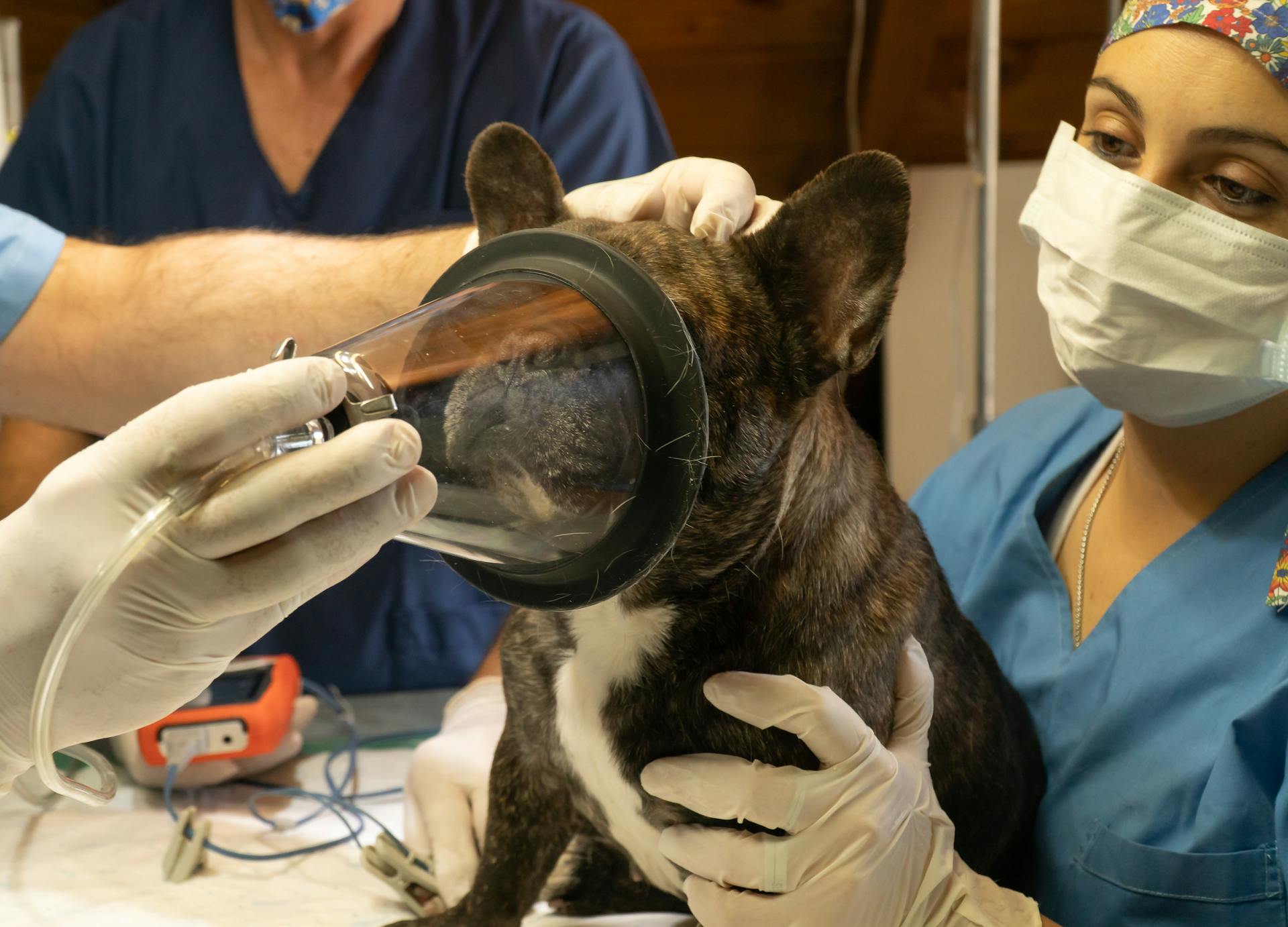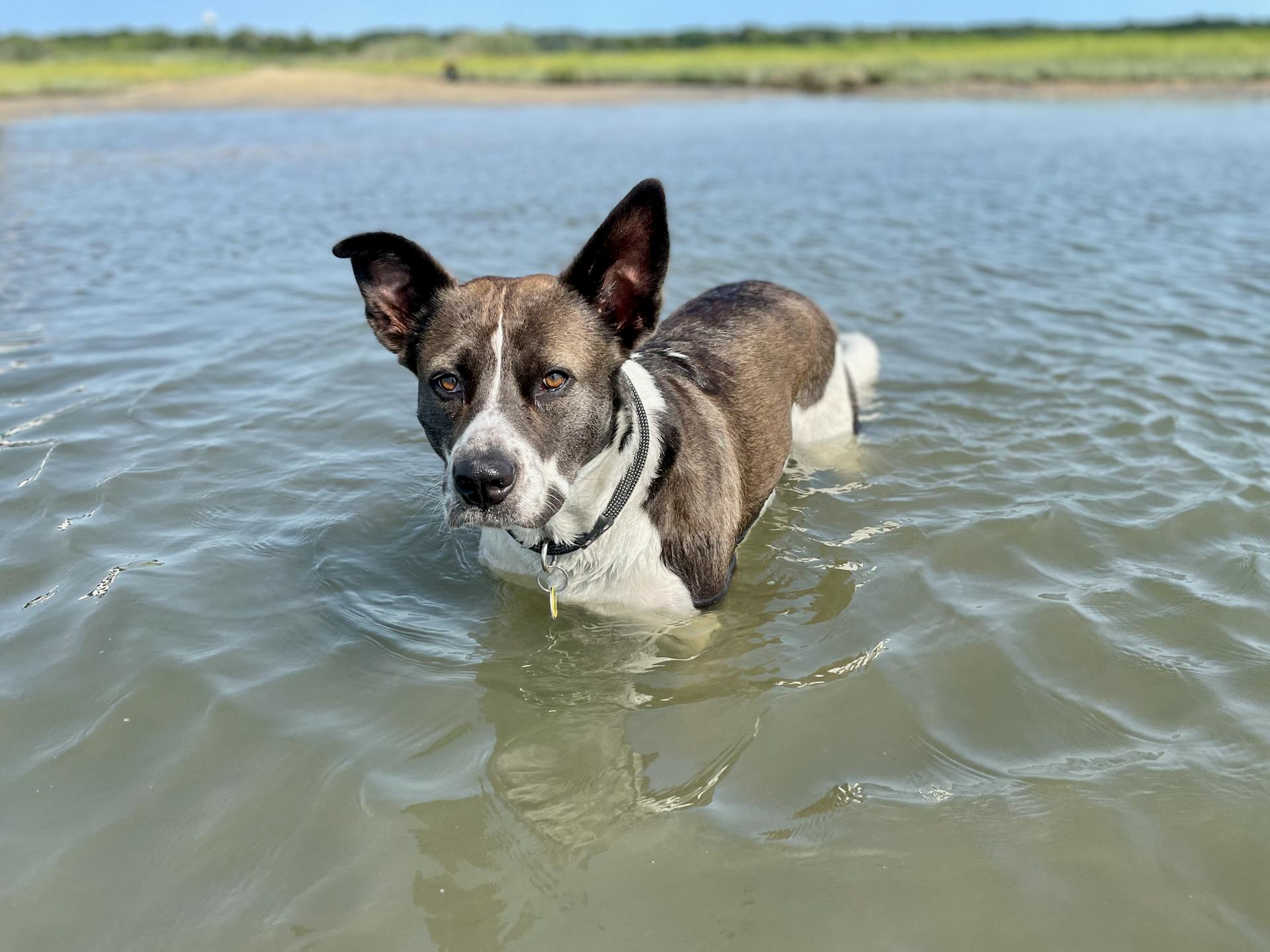
Canine gastropexy is a surgical procedure that involves attaching the stomach to the abdominal wall to prevent gastric dilation-torsion, a life-threatening condition that can occur in deep-chested breeds.
This procedure is typically performed in breeds such as Great Danes and Irish Wolfhounds due to their deep chest anatomy, which can lead to gastric dilation-torsion.
The goal of canine gastropexy is to prevent gastric dilation-torsion by stabilizing the stomach and preventing it from twisting.
By performing this procedure, pet owners can reduce the risk of their dog experiencing this potentially fatal condition.
For your interest: Anatomy of Canine Stomach
Preventing GDV and Surgery
Preventing GDV is crucial for large and deep-chested breeds, especially Great Danes, which have a 40% likelihood of developing GDV at some point in their life.
Prophylactic gastropexy, performed at the time of spaying or neutering, significantly reduces this likelihood. A gastropexy can be performed laparoscopically or endoscopically, but this is less common due to the specialized equipment required.
Dogs at risk of GDV can be prevented from developing the condition by exercising shortly after eating, eating rapidly, or consuming large amounts of water and food.
Preventing GDV can also prevent the need for emergency surgery to untwist the stomach and perform a gastropexy. A gastropexy performed after GDV has occurred reduces the risk of recurrence from 80% to less than 5%.
Gastropexy is an outpatient procedure, meaning your pet does not need to stay overnight. However, it's essential to ensure your pet receives pre-anesthetic blood work to detect any underlying health concerns.
Here are some at-risk dog breeds that may benefit from a gastropexy:
- Great Danes
- German shepherds
- Standard poodles
- Basset hounds
- Weimaraners
- Irish setters
Surgery and Post-Operative Care
Before undergoing gastropexy surgery, your dog will need to fast for a certain period, which will be determined by your veterinarian. This is to ensure your dog's safety and comfort during the procedure.
The gastropexy procedure itself is typically an outpatient procedure, lasting only a few hours, and your dog will be under general anesthesia. Your veterinarian will prepare the surgical site by shaving and cleaning the area to minimize the risk of infection.
After surgery, your dog will need to be kept calm for 7 to 14 days to allow the incision to heal. This means no running, jumping, or strenuous activity, and your dog should avoid swimming or bathing to keep the incision clean and dry.
Here are some specific post-operative care instructions to keep in mind:
- No running, jumping, playing, swimming, or other strenuous activity.
- No bathing or grooming during the recovery period.
- No licking or chewing at the incision site.
- Use an Elizabethan collar to prevent your dog from manipulating the incision site.
Your dog may be sent home with pain medication and antibiotics to ensure a smooth recovery. Be sure to follow your veterinarian's instructions regarding medication administration and dosage.
Types of Gastropexies
There are several types of gastropexies that veterinarians can perform to prevent gastric dilatation-volvulus (GDV) in dogs. The most common technique used is incisional gastropexy, which involves making an incision in the stomach and suturing it to the abdominal muscles.
This method is preferred because it's the fastest and has fewer complications compared to other forms of gastropexy. In fact, it's the most common method used by veterinarians.
Another type of gastropexy is laparoscopic-assisted gastropexy, which uses endoscopes to perform the surgery. This method is often preferred in clinics with laparoscopic capabilities, as it results in smaller incisions.
The laparoscopic-assisted gastropexy technique is basically the same as an incisional gastropexy, but with the added benefit of smaller incisions.
A few other types of gastropexies include belt-loop gastropexy, circumcostal gastropexy, and tube gastropexy. These methods involve different techniques, such as passing a flap of the stomach through a tunnel in the abdominal wall or wrapping a seromuscular flap around the last rib.
Here are the four common types of gastropexies:
- Incisional gastropexy
- Belt-loop gastropexy
- Circumcostal gastropexy
- Laparoscopic-assisted gastropexy
It's worth noting that there are more gastropexy methods, but incisional or laparoscopic-assisted gastropexies are typically preferred.
Procedure
Before your dog undergoes gastropexy surgery, a thorough pre-surgical examination will be performed to ensure they are a good candidate for anesthesia.
Your veterinarian will recommend that your pet receives pre-anesthetic blood work to detect any potential health concerns.
Your pet will be under general anesthesia during the procedure.
The surgical team will prepare the surgical site by shaving and cleaning the area to remove bacteria and decrease the risk of infection.
A gastropexy is an outpatient procedure, which means your pet won't need to stay overnight.
The gastropexy procedure involves tacking the right side of the stomach to the right side of the abdominal wall to prevent shifting and twisting.
There are several types of gastropexy procedures, including incisional, laparoscopic-assisted, belt-looped, circumcostal, tube, and incorporating gastropexy.
Here are some of the specific types of gastropexy procedures:
Your dog will need to fast prior to the procedure, and you should get precise instructions from your veterinarian regarding the fasting period.
Post-Surgery Care
After surgery, it's essential to keep your dog calm for 7 to 14 days to allow healing.
You'll need to restrict their activity, avoiding running, jumping, and rough play. No swimming or bathing is allowed, either, to keep the incision clean and dry.
Monitor your dog's incision daily for the first week, checking for increased redness, swelling, discharge, or pulling apart.
To prevent licking or chewing at the incision, consider using a recovery cone or suit. Your veterinarian may also recommend a specific diet and/or medication to protect the gastrointestinal tract.
Dogs undergoing an emergency gastropexy may require more involved post-operative care, including heart arrhythmia monitoring and medication.
Your dog will likely be sent home with pain medication, which should be used exactly as directed. If they refuse to eat, you can try offering a bland diet like white rice and lean protein.
Here's a general feeding schedule to follow:
- Feed small meals spread throughout the day for the first week.
- Separate your dog's daily allotment of food into 3-5 meals.
- Offer a small amount of food and water of canned or moistened dry food when they return home.
- Wait 12 hours before offering more food if vomiting occurs.
Typically, pets fully recover within 10-14 days of gastropexy surgery. During this time, keep your dog indoors, supervised, and on a leash for walks. No off-leash activity or strenuous exercise is allowed, and you should avoid bathing or grooming them.
Frequently Asked Questions
What is the success rate of gastropexy in dogs?
The success rate of gastropexy surgery in dogs is around 80% when performed promptly. Early veterinary intervention is crucial for optimal recovery outcomes.
Featured Images: pexels.com


